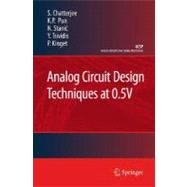
What is included with this book?
| Introduction | p. 1 |
| Low-voltage analog circuit design challenges | p. 4 |
| Opportunities at low voltages | p. 9 |
| Organization of the book | p. 14 |
| Fully Differential Operational Transconductance Amplifiers (OTAs) | p. 17 |
| Body-input OTA | p. 19 |
| Gate-input OTA | p. 23 |
| On-chip biasing circuits for the gate-input OTA | p. 29 |
| Error amplifier | p. 30 |
| Generating a fixed level shift | p. 31 |
| Setting the OTA output DC common-mode voltage | p. 32 |
| Gain enhancement | p. 33 |
| Start-up | p. 35 |
| Characterization results for the body-input and gate-input OTAs | p. 35 |
| Body-input OTA measurements | p. 35 |
| Gate-input OTA measurements | p. 36 |
| Discussion on the two OTA design techniques | p. 39 |
| Design methodology for low V[subscript T] devices, without body access | p. 41 |
| Fully differential OTA | p. 41 |
| Bias circuits | p. 45 |
| Summary | p. 45 |
| Weak Inversion MOS Varactors for Tunable Integrators | p. 49 |
| Brief theoretical overview | p. 50 |
| Device measurements and modeling | p. 50 |
| Closed-form model | p. 52 |
| Channel segmentation | p. 54 |
| Comparison between measured results and simulations | p. 56 |
| Circuit applications | p. 56 |
| Discrete prototype using the varactor | p. 56 |
| Application of the varactor in an integrated setting | p. 56 |
| Summary | p. 60 |
| A 0.5 V 5th-Order Low-Pass Elliptic Filter | p. 61 |
| Filter topology | p. 61 |
| On-chip PLL-based automatic frequency tuning loop | p. 62 |
| Layout and prototype chip | p. 65 |
| Characterization Results | p. 66 |
| Test set-up | p. 66 |
| Frequency response | p. 66 |
| Noise | p. 67 |
| Distortion and characterization over tuning range | p. 67 |
| Performance at different power supply voltages | p. 69 |
| Performance over different chips | p. 69 |
| Performance over temperature | p. 71 |
| Summary | p. 71 |
| A 0.5 V Track-and-Hold (T/H) Circuit | p. 77 |
| Introduction | p. 77 |
| T/H operation at ultra-low voltages | p. 77 |
| Fully-differential 0.5 V T/H circuit | p. 79 |
| Charge injection and sampling times | p. 80 |
| Fully-differential implementation | p. 81 |
| Common-mode rejection | p. 81 |
| Integrated noise | p. 83 |
| Track-and-hold test strategy | p. 86 |
| Design details and measurement results | p. 86 |
| Gate-input OTA | p. 86 |
| Switches | p. 87 |
| Clock generation | p. 87 |
| Prototype chip | p. 90 |
| Simulated performance | p. 91 |
| Measured performance | p. 91 |
| Conclusion | p. 92 |
| A 0.5 V Continuous-Time [Sigma Delta] Modulator | p. 97 |
| Introduction | p. 97 |
| Return-to-Open DAC | p. 98 |
| Similar DAC concepts | p. 99 |
| Noise improvements by RTO DAC | p. 102 |
| Return to Zero timing | p. 103 |
| Split RTO DAC Modulator Architecture | p. 103 |
| Modulator clocking | p. 104 |
| Modulator design | p. 105 |
| Values of R and C | p. 106 |
| Building Block Circuits for 0.5 V Supply | p. 108 |
| RTO DAC Circuit | p. 108 |
| Comparator | p. 110 |
| Operational transconductance amplifiers | p. 110 |
| Clock generation circuit | p. 112 |
| Experimental Results | p. 112 |
| Conclusions | p. 120 |
| 0.5 V Receiver Front-End Circuits | p. 121 |
| Introduction | p. 121 |
| RF Receiver System-Level Considerations | p. 121 |
| Low-Noise Amplifiers | p. 122 |
| Basic Properties and Standard Topologies | p. 122 |
| Low-Voltage Considerations | p. 123 |
| Downconversion Mixers | p. 124 |
| Basic Properties and Standard Topologies | p. 124 |
| Low-Voltage Considerations | p. 126 |
| 900 MHz Receiver Front-End in 0.18 [mu]m CMOS | p. 127 |
| Design of the LNA | p. 127 |
| Design of the downconversion mixer | p. 130 |
| Design of the LO buffers | p. 134 |
| Measurement and results | p. 135 |
| Analysis of a Distributed Model for a MOS Capacitor | p. 141 |
| References | p. 147 |
| Index | p. 155 |
| Table of Contents provided by Ingram. All Rights Reserved. |
The New copy of this book will include any supplemental materials advertised. Please check the title of the book to determine if it should include any access cards, study guides, lab manuals, CDs, etc.
The Used, Rental and eBook copies of this book are not guaranteed to include any supplemental materials. Typically, only the book itself is included. This is true even if the title states it includes any access cards, study guides, lab manuals, CDs, etc.